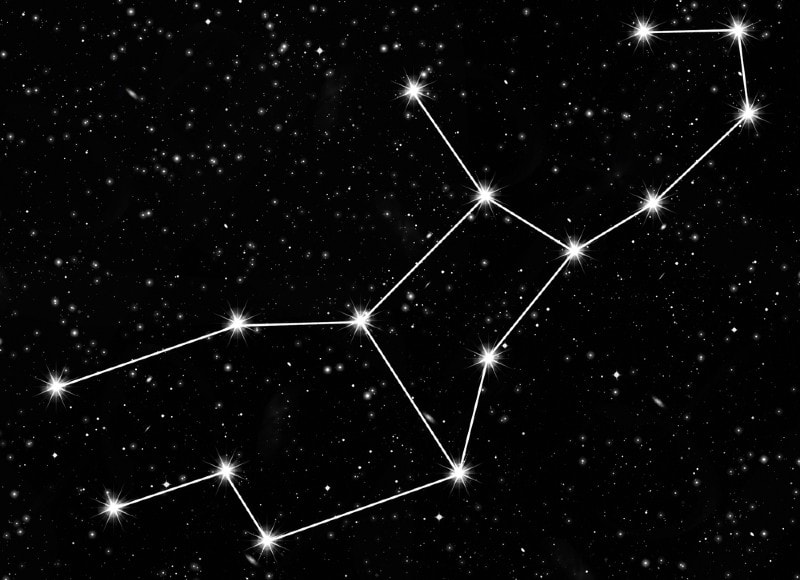What Constellation Is Spica In? The Interesting Answer!
Last Updated on

Spica is one of the brightest stars in the night sky. It is easy to spot and has a blueish color, causing many people to wonder if it belongs to a constellation. It does, in fact, belong to the constellation Virgo. Keep reading as we uncover more interesting facts about this bright star and how to locate it in the night sky. We also discuss the Virgo constellation, what it looks like, and where you can find it.

What Is Spica?
Spica is the 16th brightest star in the night sky and sits about 250 light years away. It is the closest binary star system, with two closely positioned stars. Its name gives away its location, as its full title, Spica Virginis, is Latin for “Virgos Ear of Grain.” It represents the ear of corn that the constellation Virgo holds in her right hand. In ancient times, Greek and Roman cultures associated this constellation with the goddess Demeter, who looked over the harvest of grain.
Why Is Spica So Bright?
Spica is bright due to its proximity to the Earth at a distance of only 250 light years. Many other stars are thousands of light years away. Another reason that it is so brilliant is that it is quite large. Also, there are two stars in the system, Spica 1 and Spica 2. Both are significantly larger than our sun and many times as bright. They are also part of spectral class B, giving Spica its blue color. Since the stars are so close, gravity pulls them toward each other, causing them to take on an egg shape. However, we are unable to see the egg shape from Earth.

What Is the Virgo Constellation?
Virgo is the second largest constellation in the night sky, and you can see it in both the northern and southern hemispheres. If you live in the north, you will want to look for it from March to July, while people in the southern hemisphere can see it during the fall and winter months. The story behind the constellation is complex, with many variations, and no one is sure exactly who Virgo represents. One story tells of Dionysus offering wine to Icarius, a winemaker, and local shepherds out of friendship. However, the drunken shepherds thought that they were poisoned and killed Icarius for revenge. Later, his daughter, Erigone, found his body and buried him before hanging herself out of grief. When Dionysus learned what had happened, he was angry and caused a plague to overtake the city of Athens before placing Erigone among the stars as Virgo. He placed Icarius next to her in the sky as the constellation Boötes.
Finding Virgo in the Night Sky
If you live in the northern hemisphere, seek out Virgo close to the horizon between 9 p.m. and 10 p.m. in March and April. If you live in the southern hemisphere, look for it close to the eastern horizon at around 11 p.m. in early October

Other Interesting Facts About Spica and the Virgo Constellation
- The two stars that make up the Spica star that we see on Earth are so close that scientists can only see both by looking at their spectra, which is a temperature measurement around a star.
- The primary star in Spica is a blue giant.
- Spica and the stars Arcturus and Regulus make up the Spring Triangle asterism, which is a constellation within other constellations. Adding the star Cor Caroli to the other three creates the Spring Diamond asterism.
- Many objects in the solar system, including the moon and many planets, can block our view of the Spica star.
- Venus passes in front of Spica once every 8 years.
- The main star of Spica is more than 20 times brighter than our sun.
- The secondary star of Spica is about 2.25 times brighter than the sun.
- The stars in Spica orbit each other once every 4 days.
- There are several galaxy clusters within the borders of the Virgo constellation.
- Using an amateur telescope, you can spot the famous Sombrero galaxy inside the Virgo constellation.
- Virgo is one of the 12 signs of the zodiac.
- Scientists have discovered many planets around the stars that make up the Virgo constellation.
- Virgo is one of the original 48 constellations that the ancient astronomer Ptolemy first cataloged in ancient times.

Summary
Spica is a binary star that you can find in the Virgo constellation. The constellation is one of the largest in the night sky, and you can see it from the northern and southern hemispheres. It also includes many cluster galaxies and the bright, easy-to-spot Sombrero galaxy, making it a great choice for beginner astronomers. In the northern hemisphere, look for Virgo in the early spring, and people in the southern hemisphere should look for it in early autumn. It’s easy to spot because Spica is one of the brightest stars in the sky.
Featured Image Credit By: Piqsels
About the Author Ed Malaker
Ed Malaker is a veteran writer who contributes to a wide range of blogs covering information on computer programming, pets, birding, tools, fitness, guitars, and optics. Outside of writing, Ed is often found working in the garden or performing DIY projects in the house. Ed is also a musician, spending his time composing music for independent films or helping people repair their guitars.
Related Articles:
What Is the Best Binocular Magnification for Hunting? Optical Features Explained
15 Crucial Facts About Ultraviolet Rays & the Sun
10 Interesting Leo Constellation Facts, Myths, and FAQs
15 Interesting Pegasus Constellation Facts, Myths, and FAQs
6 Interesting Sagittarius Constellation Facts, Myths, and FAQs in 2024!
What Are Constellations? Where Did They Come From?
8 Interesting Libra Constellation Facts, Myths, and FAQs
What Is Infrared Radiation? Science-Based Facts & FAQ
